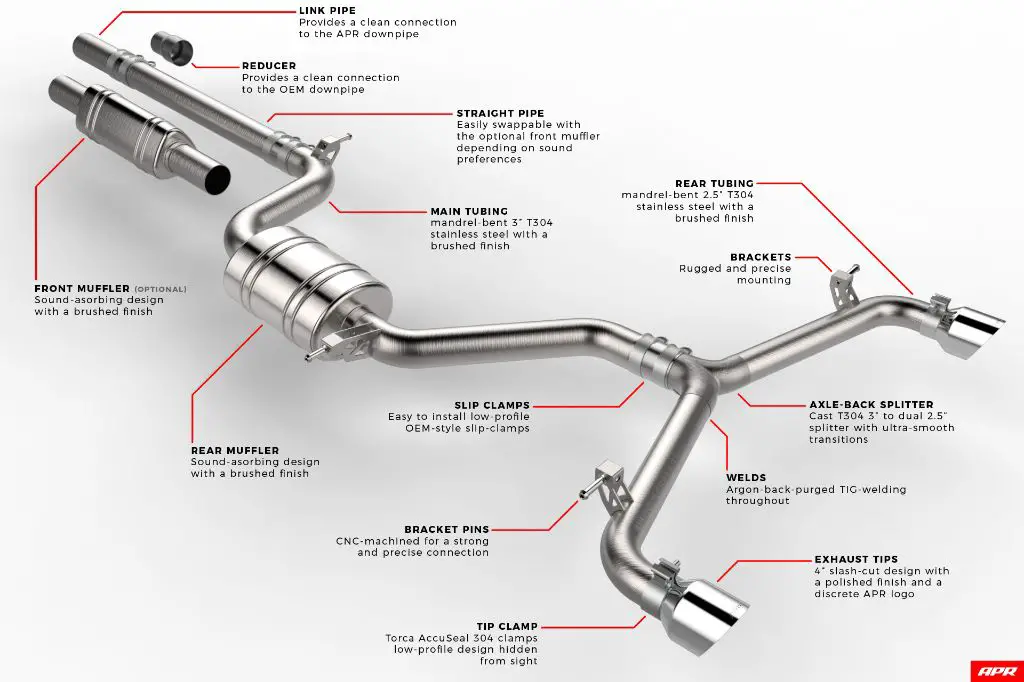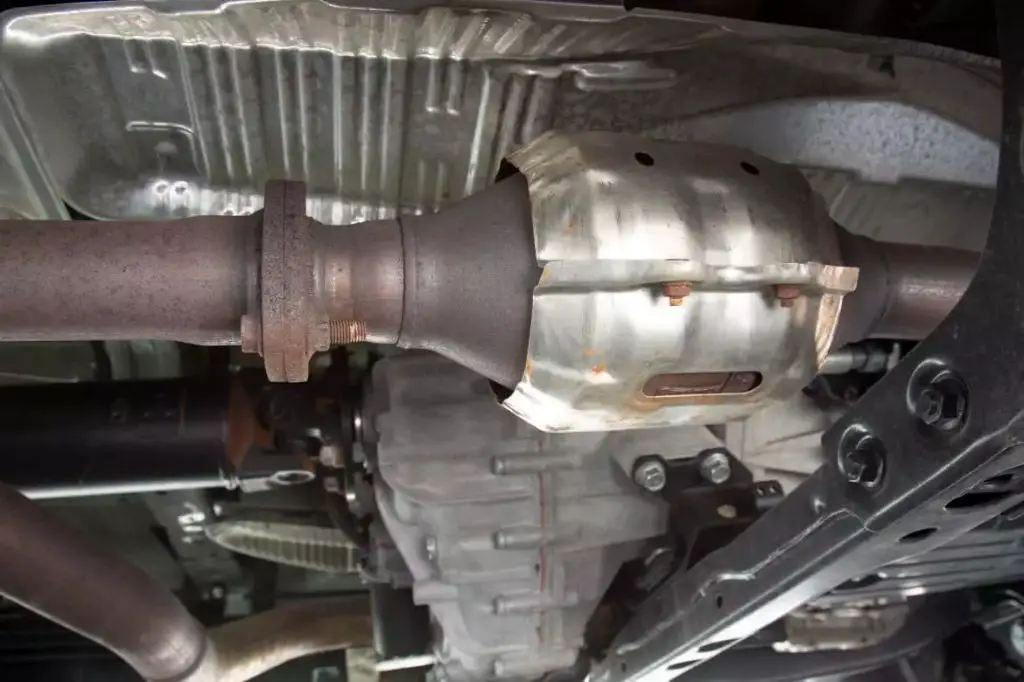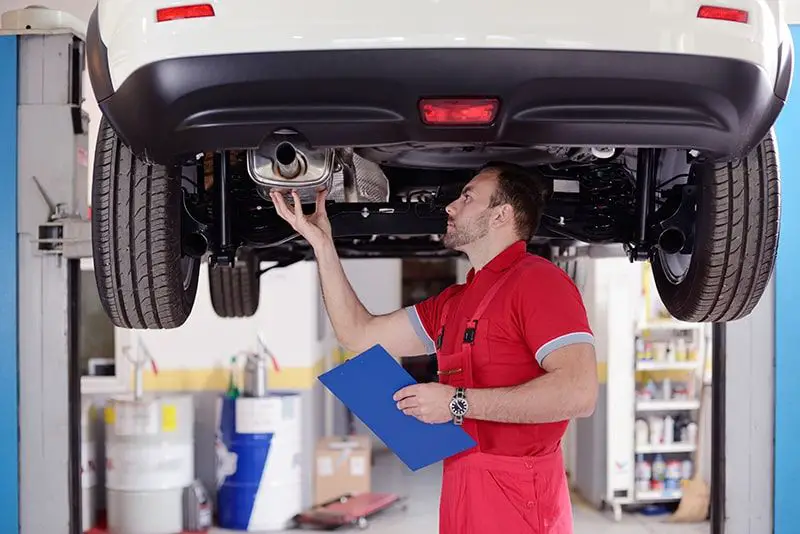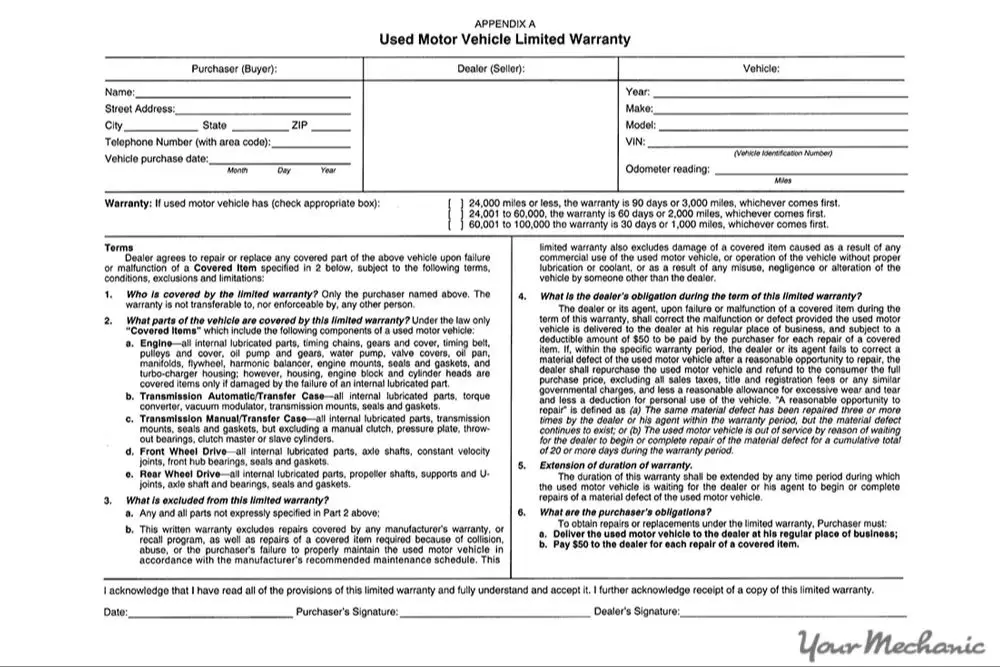What is a Cat Back Exhaust?
A cat-back exhaust system refers to the portion of the exhaust system from the outlet of the catalytic converter (or “cat”) to the tailpipes at the rear. This includes the mid pipe section, muffler, and tail pipes [1].
The main components of a cat-back exhaust system are:
- Mid pipe – Connects the catalytic converter to the muffler
- Muffler – Designed to reduce exhaust noise
- Tail pipes – The final pipes at the rear of the vehicle

Installing an aftermarket cat-back exhaust system can provide several benefits such as [2]:
- Increased horsepower and torque
- Better fuel efficiency
- Enhanced engine sound
Do Aftermarket Exhausts Void Warranties?
The Magnuson-Moss Warranty Act is a federal law passed in 1975 that provides consumer protections for warranties on products. According to the Magnuson-Moss Warranty Act, vehicle manufacturers cannot void a warranty or deny coverage solely because aftermarket or recycled parts were installed, unless they can prove that the aftermarket part caused the need for repairs. Simply installing an aftermarket part does not automatically void the warranty.
However, there are exceptions when it comes to emissions control equipment. Federal emissions performance warranties can be voided if the aftermarket part is proven to negatively affect emissions performance. This means that modifying the catalytic converter or emissions sensors could potentially void that portion of the warranty.
Overall, most aftermarket exhaust modifications like cat-backs should not void the warranty, as long as they are not tampering with emissions equipment. The manufacturer would have to conclusively prove that the aftermarket exhaust caused damage elsewhere in the drivetrain. But it is still a good idea to keep the original exhaust system in case any warranty issues arise down the road. For more information, see the Magnuson-Moss Warranty Act and Aftermarket Parts.
Emissions Equipment Warranty
Catalytic converters are required emissions control devices by the Environmental Protection Agency (EPA) and National Highway Traffic Safety Administration (NHTSA). All vehicles sold in the United States must be equipped with cats to reduce harmful pollutants in exhaust emissions.

The emissions control equipment, including catalytic converters, is covered by a federal emissions warranty for 2 years or 24,000 miles from the vehicle’s in-service date. This protects against defects in materials and workmanship. Replacing the original catalytic converters with aftermarket ones or completely removing them can potentially void this emissions equipment warranty according to the Magnuson-Moss Warranty Act.
Modifications made downstream of the catalytic converters, like a cat-back exhaust system, generally do not void the emissions warranty as long as the cats remain untouched. But deleting the primary catalytic converters closest to the engine is considered tampering with emissions equipment and can allow the manufacturer to deny warranty coverage if it can be proven that the modification caused the failure.[1]
[1] https://www.camaro6.com/forums/showthread.php?t=547886
Proof of Causation
For a warranty claim to be denied due to modifications, the manufacturer must prove that the aftermarket part or modification caused the failure or damage. The burden of proof is on the manufacturer, not the vehicle owner. Simply having an aftermarket exhaust does not automatically void the entire warranty.
According to the Magnuson-Moss Warranty Act, a modification only voids the warranty on the parts it affects. So installing a cat back exhaust would only void the emissions warranty, not the entire powertrain warranty. The manufacturer must demonstrate that the exhaust caused the specific issue to deny a repair claim.
For example, if the transmission fails, they cannot deny a repair claim just because you have an aftermarket exhaust. They would need to prove the exhaust specifically caused the transmission failure, which is very unlikely. The warranty remains intact on unrelated components.1
Cat Back Exhaust Effects
A cat back exhaust system replaces the exhaust piping from behind the catalytic converter to the rear of the vehicle. This means it generally has little to no effect on emissions equipment like the catalytic converter and oxygen sensors (source).
Performance increases from a cat back exhaust alone are fairly minor. Horsepower and torque gains are usually in the 5-15 hp and 5-10 lb-ft range since the exhaust manifold and catalytic converter remain stock (source).
The most noticeable impact of installing a cat back exhaust is the change in sound. Aftermarket systems use less restrictive piping which allows more audible exhaust tone. This gives the engine a deeper, louder sound under acceleration.
Will a Dealer Notice?
There are a few ways a dealer may notice an aftermarket exhaust system during routine service or inspection:

Visual Inspection – Technicians will likely spot an aftermarket exhaust just by looking under the car during an oil change or inspection. Aftermarket exhausts often have unique designs, larger piping, or different finish colors from the factory system.
CEL Check – The technician may plug into the OBD port to check for any trouble codes that could indicate an exhaust issue. Aftermarket exhausts can sometimes trigger check engine lights.
Sound Judgment – The tech will likely hear the different exhaust tone when moving the car or starting it up. An aftermarket system usually has a deeper or louder sound.
So in most cases, an experienced service technician at a dealer will notice if an aftermarket exhaust has been installed. But it still depends on the individual and how closely they inspect the vehicle.
Claim Denial Scenarios
Even though installing a catback exhaust system doesn’t directly void the warranty, the dealer can still deny warranty claims by arguing the aftermarket part caused damage or failure. Here are some common claim denial scenarios related to exhaust mods:
Emissions Equipment Failure
The manufacturer is required to warranty emissions equipment under federal law for 8 years/80,000 miles. If an oxygen sensor or catalytic converter fails, the dealer may try to blame the aftermarket exhaust and refuse to cover it under the emissions warranty. However, they would need proof it was directly caused by the exhaust mod and not a defect in materials or workmanship [1].
Engine Damage
In rare cases, the dealer may claim the aftermarket exhaust caused damage to the engine or other components by altering air/fuel ratios. However, reputable manufacturers design catback systems to avoid these issues so the dealer would need to conclusively prove the exhaust was the root cause [2].
Rattle or Leak
If you experience a rattle or leak from a poor aftermarket exhaust installation, the dealer can refuse to cover it under warranty. Make sure to have a reputable shop install the exhaust to avoid fitment issues.
Warranty Protection Tips
If you want to modify your exhaust while preserving your warranty, here are some tips:
Keep the stock exhaust – Some manufacturers may void the warranty if you replace the entire exhaust system. Keeping just the stock exhaust manifold, catalytic converter, and piping can help protect the emissions warranty.
Quality install by a professional – Have the exhaust work done by a reputable performance shop to ensure it is installed properly. Get installation records as proof in case any warranty issues arise.
Consider ECU tuning – Adding a high-flow exhaust may throw off the air-fuel mixture. Get an ECU tune to optimize performance and prevent potential engine issues that could lead to warranty denial.
Overall, use high-quality parts and professional installation while keeping critical emissions components stock. This will allow you to modify the exhaust for more performance while maintaining warranty coverage from the manufacturer. Document any work done on the vehicle for additional protection.
Alternatives to Exhaust Mods
For those looking to modify their vehicle for performance or style while avoiding potential warranty issues, there are several alternatives to cat-back exhaust systems worth considering:
Engine tuners and intakes can help boost horsepower while maintaining emissions compliance. Manufacturer-approved tuners like the Hondata Flashpro for Honda/Acura vehicles offer gains while minimizing warranty risk. Aftermarket air intakes often just replace factory parts with similar designs, so unlikely to cause issues.
Suspension, wheels, tires and appearance modifications like lowering springs, big brake kits and blacked out wheels still allow the original exhaust system to work as intended. As long as these mods don’t directly impact emissions systems, they’re typically warranty-friendly. Check manufacturer guidelines on wheel/tire fitment.
For drivers wanting more aggressive exhaust sound without replacing catalytic converters, sound generators can amplify the note. Some examples are resonators, valve actuators to open/close exhaust valves and electronically amplified systems. These often don’t modify emissions equipment.
Making a Claim with Modifications
If you have modified your vehicle’s exhaust system, be upfront about it if the dealership asks during the warranty claim process. While modifications like a cat back exhaust may void portions of the emissions warranty, it’s important to focus your claim on unrelated parts of the vehicle.

For example, if your transmission fails, point the dealer to that issue specifically and avoid discussing any exhaust modifications unless asked. Dealerships often look for ways to deny claims, so voluntarily providing information on modifications gives them an easy out.
It’s also important to know your consumer rights. The Magnuson–Moss Warranty Act states that dealers must prove any modifications caused the failure in order to deny a claim. You may need to firmly assert your rights if the dealership points to modifications as a blanket claim denial.
Having records of maintenance and mods also helps prove you haven’t neglected the vehicle. While exhaust mods can still risk claim denial, being an informed consumer and focusing arguments on unrelated failures gives you the best chance at success.

